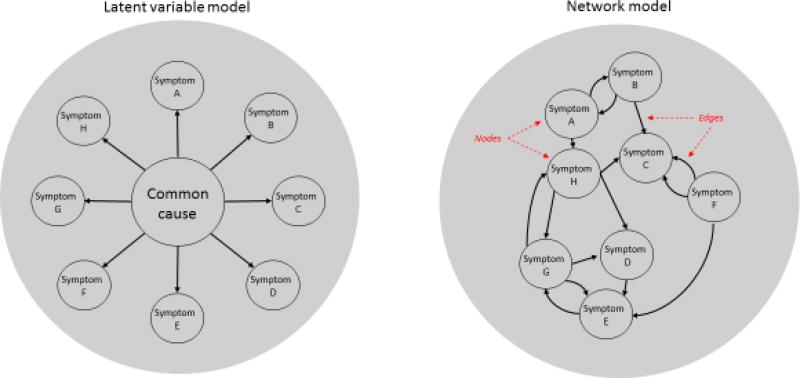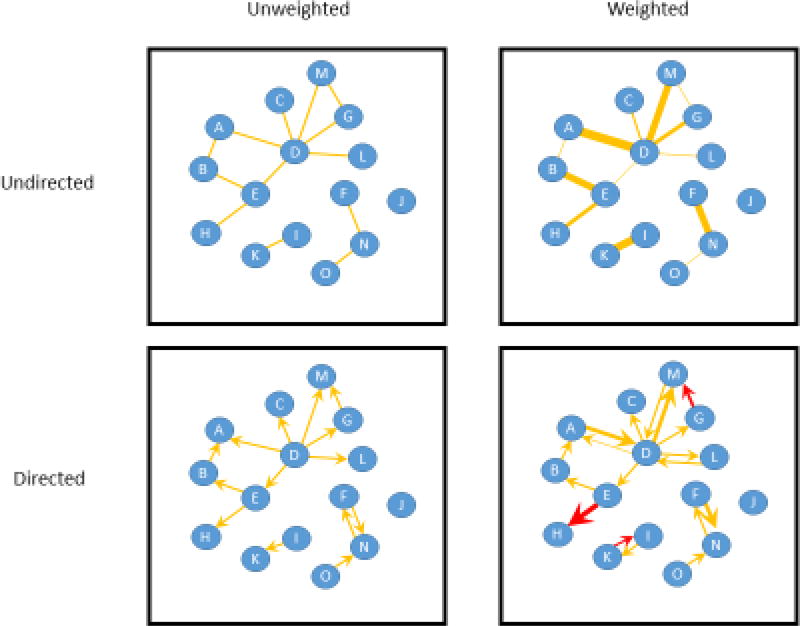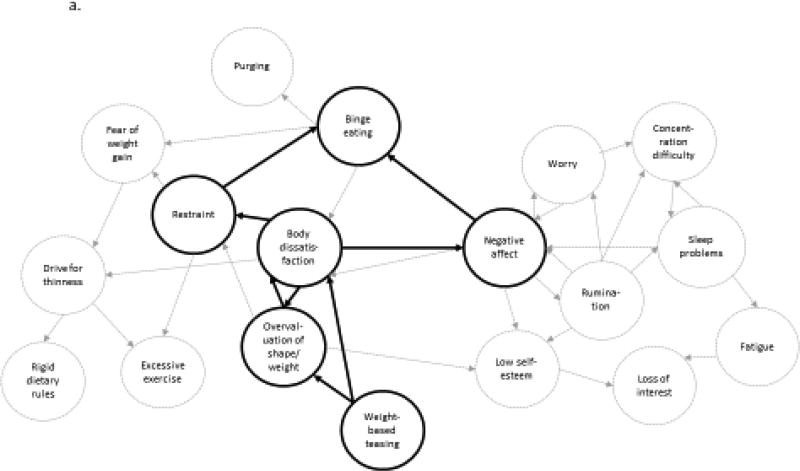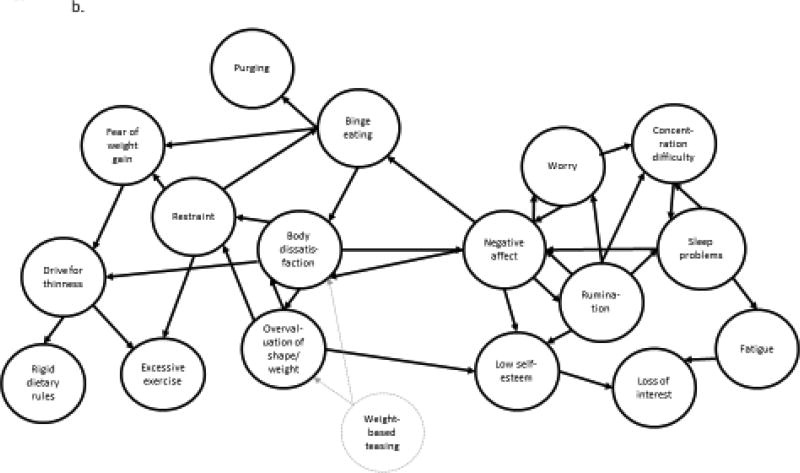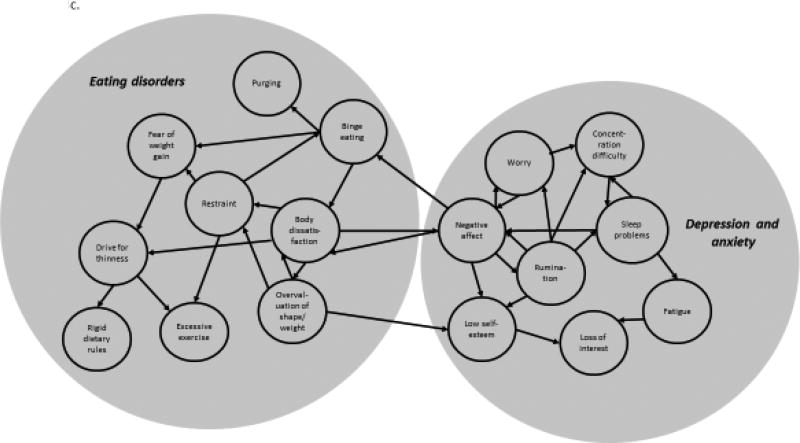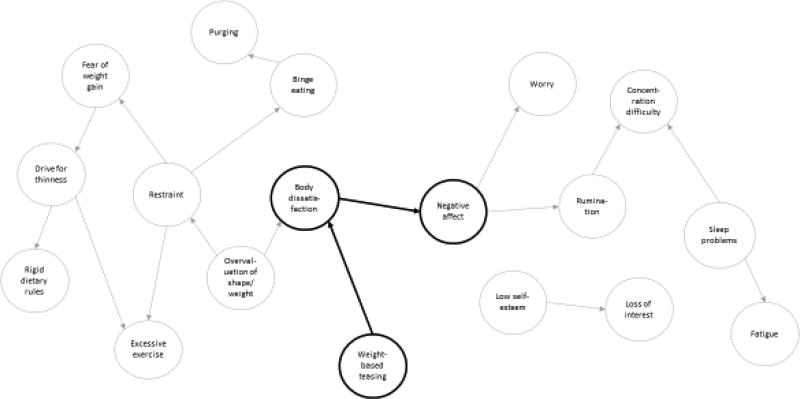Abstract
Network theory and analysis is an emerging approach in psychopathology research that has received increasing attention across fields of study. In contrast to medical models or latent variable approaches, network theory suggests that psychiatric syndromes result from systems of causal and reciprocal symptom relationships. Despite the promise of this approach to elucidate key mechanisms contributing to the development and maintenance of eating disorders (EDs), thus far, few applications of network analysis have been tested in ED samples. We first present an overview of network theory, review the existing findings in the ED literature, and discuss the limitations of this literature to date. In particular, the reliance on cross-sectional designs, use of single-item self-reports of symptoms, and instability of results have raised concern about the inferences that can be made from network analyses. We outline several areas to address in future ED network analytic research, which include the use of prospective designs and adoption of multi-modal assessment methods. Doing so will provide a clearer understanding of whether network analysis can enhance our current understanding of ED psychopathology and inform clinical interventions.
Keywords: eating disorders, network theory, network analysis, nosology, classification, assessment
Introduction
Clinicians and researchers in the eating disorder (ED) field are faced with heterogeneous symptom presentations within diagnostic categories (e.g., Wildes et al., 2011; Wonderlich et al., 2005), diagnostic migration (e.g., Eddy et al., 2008), and substantial comorbidity (e.g., Hudson et al., 2007), all of which pose challenges for treatment planning and research on etiology, course, and outcome. As a result, a burgeoning literature has attempted to address ED classification problems using empirical approaches. For example, empirical approaches to testing categorical models (e.g., latent class analysis) assume there are distinct homogeneous subgroups of people with various forms of psychopathology. Empirical approaches to testing dimensional models (e.g., factor analysis) attempt to identify underlying continua by which to characterize types of psychopathology. Hybrid empirical approaches (e.g., factor mixture modeling) allow for the presence of both discrete categories and underlying dimensions.
Past empirical approaches (e.g., latent class/profile analysis, factor analysis, and mixture models) have value in their potential to inform and refine existing nosology systems. However, these approaches assume the presence of latent categories and/or dimensions that give rise to observable symptoms, which is largely reflective of a historical tendency to apply a disease model to psychopathology (e.g., McNally, 2016). Such common cause models suggest that psychiatric disorders have a latent cause that gives rise to psychopathology. As others have noted, latent variable models of psychopathology are not without limitations (Borsboom, 2017; McNally, 2016). Unlike certain medical conditions, psychiatric disorders have yet to be identified separately from the symptoms that define them and, thus far, researchers have yet to determine a single etiological factor or mechanism that causes EDs (Figure 1). In contrast to prior latent variable model approaches, network theory suggests that psychiatric disorders arise from a complex array of causal and reciprocal relationships among symptoms, rather than directly from latent diagnoses (Borsboom, 2017). In the remainder of this paper we present an overview of network theory and suggest avenues for future applications in the ED field.
Figure 1.
Latent variable versus network models
Network theory and analysis
Network theory graphically and quantitatively models associations among constructs, and has been applied in several other fields such as biology, sociology, economics, and engineering. In recent years, network science has received increasing attention among taxometricians and researchers across different fields of psychopathology. Broadly, a network is any interconnected system of elements (i.e., nodes). Network research in psychopathology posits that core symptoms (i.e., nodes) and symptom relationships constitute potential “building blocks” of psychiatric illnesses, in that the relationships between symptoms are not merely a result of an underlying illness liability, but actually have causal significance in the development of psychopathology. Such an approach differs from traditional disease models of psychopathology that posit latent-disease construct gives rise to psychiatric symptoms (Figure 1). Despite important advantages of latent variable approaches, including reduced measurement error and increased reliability, latent variable approaches differ fundamentally from network models in how they model the covariation (correlation) among symptoms. Whereas latent variable frameworks model shared variance among symptoms, network analyses estimate unique variance between symptoms. That is, network theory posits that it is causal relationships among symptoms that gives rise to the phenomenology of psychiatric illnesses, while latent variable models posit that an underlying common cause activates multiple symptoms and, therefore, accounts for symptom covariation.
Outside of EDs, findings from network studies have identified centrally important symptom relationships in several diagnoses. For example, fatigue or loss of energy, feeling guilty, and psychomotor retardation emerged as central symptoms among networks of those with persistent depression (van Burkolo et al., 2015); a recent network analysis by McNally and colleagues (2017) indicated that the degree of interference associated with obsessions in obsessive-compulsive disorder was a critical link to co-occurring depressive symptoms, specifically sadness. Additionally, a network analysis of individuals with depression demonstrated that symptoms of anxiety evidenced similar importance in the network as symptoms that represented DSM criteria for depression (e.g., sad mood; Fried, Epskamp, Nesse, Tuerlinckx, & Borsboom, 2016). Importantly, such findings may indicate a need for interventions to broaden treatment targets beyond those considered to be central symptoms based on current classification systems.
Network elements, structures, and indices
While a comprehensive tutorial of network analytic theory and methods is beyond the scope of the present paper and has been provided elsewhere (e.g., Borsboom & Cramer, 2013; Epskamp, Borsboom, & Fried, 2017), Table 1 briefly summarizes network elements, types of network structures, and common node and network indices. In a network structure the connections between symptoms are termed edges, which may be either unweighted (only reflecting the presence of associations) or weighted, in which the magnitude of associations are indicated by correlation coefficients. Network edges may also be directed (signifying the direction of association between nodes) or undirected (with no directionality inferred). Thus, networks can be characterized based on the types and directionality of estimated edge weights (Figure 2). In addition, the relative influence of particular nodes within a network can be evaluated by centrality indices, including strength, closeness, betweenness, and the local clustering coefficient (CC). At the systems level, network structures can also be evaluated by global indices to characterize connectivity, such as network density (i.e., the overall connectivity among symptoms), average degree (i.e., the average number of edges per node), and average CC (i.e., the average CC across all nodes).
Table 1.
Network structural elements and statistics
| Network elements | ||
| Node | Individual elements (e.g., symptoms) within a network. The size of the node may reflect strength. | |
| Edges | Connections between nodes | |
| Weighted/unweighted | Weighted edges quantify the magnitude of associations among nodes (i.e., correlation coefficient); unweighted edges only signify the presence of associations among nodes. Edge valence may be positive or negative, reflecting positive or negative associations among nodes. The thickness of weighted edges signifies the magnitude of association. | |
| Directed/undirected | Directed edges signify the direction of associations between nodes; undirected edges only reflect the presence of connections between nodes | |
| Types of network structures | ||
| Association networks | Networks consisting of undirected, weighted edges reflected by zero-order bivariate relationships (e.g., correlations) | |
| Concentration networks | Networks consisting of undirected, weighted edges signified by conditionally independent bivariate relationships (e.g., partial correlations) | |
| Relative importance networks | Networks consisting of directed, weighted edges representing the proportion of variance explained in a node while controlling for all other nodes in the network | |
| Bayesian networks | Networks consisting of directed, unweighted edges representing the direction of probabilistic relationships, resulting in directed acyclic graphs (DAGs) without feedback loops | |
| Node indices | ||
| Strength | Number of edges connecting a given node to all other nodes | |
| Indegree | The sum of absolute values of the incoming edges in a directed network, reflecting the degree to which a node is influenced by the other nodes at a previous time point | |
| Outdegree | The sum of absolute values of the outgoing edges in a directed network, reflecting the degree to which a node subsequently influences the other nodes | |
| Betweenness | Number of times a given node lies along the shortest path between two other nodes | |
| Closeness | The inverse of the sum of the shortest distance between a node a every other node | |
| Local clustering coefficient (CC) | Number of existing edges between a node’s neighbors (i.e., connected nodes) divided by the maximum possible number of edges | |
| Global network indices | ||
| Network density | Reflects the overall connectivity of a network; calculated as the ratio of the number of edges to the number of possible edges | |
| Average degree (k) | The average number of edges per node | |
| Average clustering coefficient (CC) | Average clustering coefficient across all nodes in a network | |
Figure 2.
Characteristics of network edges
What network science may add to the study of EDs
Network science offers a new perspective in the conceptualization and study of EDs, which may ultimately inform both classification and treatment approaches. In addition to the previously mentioned fundamental difference with latent variable approaches, network analysis is uniquely suited to add to the study of EDs in that it (1) accommodates the possibility that psychiatric illnesses are neither purely categorical nor purely continuous in nature, (2) allows for consideration of multiple mechanisms of onset and maintenance that may differ across persons, (3) is thought to convey important information regarding resiliency and vulnerability for ED psychopathology, and (4) may inform interventions. While network approaches have typically been conceptualized as in contrast to categorical or disease models of psychopathology, these approaches are not mutually exclusive. Referred to as hybrid models (Fried & Cramer, 2017), it is possible that there are common causes of disorders (e.g., occurrence of a trauma leading to PTSD) that account for some covariance in symptoms and play a role in maintenance (e.g., re-experiencing of the trauma), but that the network structure of symptom relationships also accounts for sustained symptom activation and maintenance over time, as reflected by direct symptom-symptom relationships (e.g., insomnia leading to fatigue, which leads to subsequent concentration difficulties, mood disturbances, and further insomnia).
As an example, in EDs, weight-based teasing may lead to body dissatisfaction and overvaluation of shape and weight, which may simultaneously lead to increased negative affect and dietary restraint (Figure 3a). While negative affect and restraint may result in ED behaviors (e.g., binge eating), at the same time negative affect and restraint may activate other clusters of related symptoms (e.g., cognitive rumination, low self-esteem) that serve to perpetuate negative affect and ED behaviors, even in the absence of the initial catalyst (e.g., weight-based teasing), and possibly lead to the emergence of co-occurring mood and anxiety symptoms (Figure 3b). Clinical syndromes therefore arise when there is sufficient activation of a set of symptoms within a network, and these clusters of symptoms are then characterized as psychiatric illnesses as we currently define them – e.g., eating disorders, depression, and anxiety (Figure 3c). In other words, activation of one domain may set off multiple “chain reactions” among other symptoms that ultimately culminates in a constellation of self-sustaining symptoms. In addition, psychiatric comorbidity may, therefore, be explained by the activation of symptoms shared by different symptom clusters (i.e., bridge symptoms; Borsboom, 2017).
Figure 3.
Initial symptom activation (3a), symptom progression and maintenance (3b), and diagnostic classifications (3c) from a network perspective
It is also important to note that the structure of connections may differ between persons, and as a result, lead to differing patterns of symptom progression and maintenance, which may account for heterogeneous ED presentations. That is, for person A there may be a strong path between body dissatisfaction, negative affect, and binge eating, which in turns activates related bulimic symptoms (e.g., purging), whereas for person B there may be a stronger link between body dissatisfaction, rigid dietary rules and dietary restraint, thereby culminating in a more restrictive ED presentation. Thus, examining both intra- and inter-individual network structures may elucidate the heterogeneous mechanisms of onset of ED and co-occurring psychopathology, as well as the ways in which symptoms perpetuate and maintain each other over time.
The structural patterns of nodes within networks may also convey important information regarding resilience and vulnerability to develop psychopathology. In a network structure, greater density of symptom connectivity is thought to reflect greater vulnerability for spread of symptom activation across the network (Borsboom, 2017). That is, densely connected networks may be susceptible to rapid activation of associated symptoms, leading to sudden transitions to a disordered state once a critical level of activation or “tipping point” is reached (Scheffer et al., 2012). Analogous to a “domino effect,” among individuals with networks of densely connected symptoms, the activation of one symptom (e.g., body dissatisfaction) by another symptom (e.g., overvaluation of shape/weight) or external stressor (e.g., weight-related teasing) is more likely to lead to widespread activation of closely related symptoms (e.g., restraint, negative affect). In contrast, loosely connected (i.e., low density) networks are more flexible and can adjust more adaptively to symptom activations and external stress. For instance, an individual with a less connected, less dense network may experience some body dissatisfaction and negative mood in response to teasing, but widespread activation of ED symptoms would not occur (Figure 4).
Figure 4.
Symptom activation in less connected, less dense (i.e., more resilient) network
Lastly, network approaches may serve to inform more precise, targeted clinical interventions. Network structures elucidate the most important symptoms contributing to the etiology and persistence of EDs at both the individual and group level. Thus, identifying and targeting the core etiological or maintenance symptom relationships may maximally disrupt network structures and prevent further symptom activation for a given individual, and potentially refine existing therapeutic frameworks for EDs.
Existing literature in EDs
To date, three network analyses in ED samples have been published using single item symptoms, largely based on self-report measures (DuBois, Rodgers, Franko, Eddy, & Thomas, 2017; Forbush, Siew, & Vitevitch, 2016; Levinson et al., 2017). In a sample of mixed ED diagnoses, Forbush and colleagues identified items that reflected shape and weight overvaluation and body-checking as central symptoms in the network structure of eating psychopathology, while feeling the need to exercise every day and items related to dietary restraint were identified as “key players,” such that removal of these items disrupted the network structure (Forbush et al., 2016). In another network analysis examining bridges between ED symptoms and mood and anxiety symptoms among adults with bulimia nervosa, fear of weight gain and overvaluation of shape and weight emerged as central symptoms, and sensitivity to physical sensations were symptoms that bridged ED to depression and anxiety symptoms (Levinson et al., 2017). Most recently, DuBois and colleagues (2017) found that shape and weight overvaluation were central symptoms within the network of individuals with EDs, and the connectivity of the global network structure was stronger among those with higher levels of overvaluation.
While these results are consistent with several theoretical frameworks and empirical studies in EDs implicating the central importance of shape and weight overvaluation (e.g., Fairburn, Cooper, & Shafran, 2003), these results also offer unique information compared to other methodologies. First, these network analyses have provided novel empirical evidence regarding the tenet that overvaluation of shape and weight drives the development and maintenance of ED symptoms. For example, while research employing structural equational modeling focuses on specific pathways of influence on one or more dependent variables, these network analyses have quantified the relative importance of particular symptoms (i.e., body-checking) in the global structure of symptoms, which is thought to convey important information about the propensity for ED symptom activation and spread (e.g., global connectivity and density). Second, the results implicating shape- and weight concerns and related behaviors as central symptoms could indicate that targeting these symptoms has the most potent and wide-spread effects in reducing or preventing ED symptoms by disrupting global network structures, which may have significant implications for the development and delivery of ED interventions. For instance, rather than addressing shape and weight concerns during the third stage of Cognitive Behavioral Therapy-Enhanced (CBT-E; Fairburn, 2008), it may be more be more effective and efficient to begin to address these targets during the initial phases of treatment. However, it is also important to note that the most central symptoms may be easily re-activated due to their high degree of connectivity; as such, the relational nature of symptoms within networks is crucial to address when considering treatment implications.
Limitations
Despite growing interest in network theory, there are significant limitations of past network studies of psychopathology that need to be addressed in future research. All ED networks studies and the majority of network analyses outside of EDs have used cross-sectional designs, which cannot provide support for causal mechanisms among symptoms. Although longitudinal network studies may identify predictive relationships, causal inferences may not be inferred from network analyses without experimental manipulation. Although ED network analyses thus far have found support for shape and weight-related concerns and behaviors being key nodes within ED network structures, ED network studies have been limited to predominantly self-reported symptoms indicated by a single item, which raises questions about the reliability of symptom measurement within these networks. Indeed, concerns have been raised regarding the generalizability (i.e., the convergence of results across similar samples) and stability (i.e., the replicability of results across randomly selected subsamples) of network analyses, which includes issues related to overfitting networks to particular datasets, accuracy of parameter estimation, and the degree to which network parameters are influenced by sampling variation (Forbes, Wright, Markon, & Krueger, in press).
However, increasing evidence has supported the replicability and generalizability of network structures across different samples (Borsboom et al., 2017; Fried et al., 2018), though this depends on the use of adequate data (e.g., using measures without skip structures) and the type of analytic techniques (Borsboom et al., 2017). Regularization procedures such as the graphical least absolute shrinkage and selection operator (glasso; Friedman et al., 2008) can be used to shrink small edges to zero, thereby reducing spurious false-positive edges and resulting in more parsimonious networks. Other recent analytic techniques (i.e., bootstrapping methods) have been developed to estimate the accuracy of network parameters (for a detailed tutorial see Epskamp et al., 2017), including edge weight bootstrapped confidence intervals (i.e., an index of the accuracy of edge weights), the correlation stability coefficient (i.e., an index of the stability of centrality indices), and the bootstrapped difference test (which tests whether network connections and centrality indices for variables differ from each other). Such indices are imperative to evaluate and report in order to address problems of replicability.
Other questions remain about the optimal method for choosing nodes to be included in psychopathology networks, how to statistically compare network and latent variable models, and the extent to which the nature of indicators (e.g., dichotomous or continuous) or specific statistical analyses account for instability of networks (Fried & Cramer, 2017). In addition, power analysis and sample size guidelines are yet unclear; while some have suggested at least three individuals per parameter, this criterion may still be insufficient (Epskamp et al., 2017).
Future directions
In sum, network science is an approach that differs fundamentally from the historical application of latent variable models in EDs. Specifically, the network approach focuses on elucidating the dynamic structure of symptom relationships and proposes an inherently different way by which the phenomenology of EDs evolve. We believe this has theoretical and clinical implications in our field, as this approach may allow us to better understand the ways in which ED symptoms both develop and maintain each other over time. In light of the aforementioned evidence and literature, here we offer several ways to apply network theory to EDs to advance our field in this area:
1. Prospective research
Given that all network analyses in EDs and most outside of EDs have relied on cross-sectional data, future designs that allow for the assessment of temporal relationships among symptoms would lend stronger support for the tenets of network theory that posit causal and reciprocal symptom relationships constitute the structure of psychopathology. For instance, multilevel vector autoregressive VAR) models can be applied in network analyses of time series data, which allow for assessment of both within-person temporal relationships and between-person differences in networks (Bringmann et al., 2013). It will be important to identify autoregressive effects or positive feedback loops with time series data in order to understand which symptoms become self-perpetuating over time (e.g., dietary restriction predicting subsequent binge eating and binge eating leading to subsequent dietary restriction); moreover, delineating reciprocally reinforcing relationships would lead to the ability to identify processes that are involved in network excitation and maintenance (Bringmann et al., 2013), which has implications for predicting ED recovery, relapse, and chronicity.
2. Characterizing heterogeneity
It is well-established that EDs are characterized by significant within-group heterogeneity, and thus estimating networks at the group level may not accurately represent symptom structures of all individuals. To this end, application of network mixture models will be useful to identify possible subgroups with more homogeneous network structures (Fried & Cramer, 2017). For example, in one subgroup of EDs, restrictive eating and rigid dietary restraint may be closely tied to anxiety and compulsive personality traits, whereas in another subgroup of individuals, dietary restraint may be more closely tied to binge eating, vomiting, and impulsive personality traits. In addition, temporal relationships among symptoms may differ significantly across persons (e.g., for person A, body dissatisfaction may to negative affect and binge eating, whereas for person B, body dissatisfaction may lead to extreme dietary restriction and excessive exercise). Thus, it will be necessary to account for heterogeneity in networks of time-series data using variability networks, which can identify the extent to which these symptom associations differ across persons (Fried & Cramer, 2017).
3. Evaluation of theoretical models
Network analysis provides a novel way in which to test theoretical models of EDs. As demonstrated by DuBois et al.’s (2017) examination of the cognitive behavioral theory of EDs, this approach will allow researchers to empirically test whether the constructs posited to be of greatest theoretical importance have the most impact on overall network structure, and test multiple pathways by which these domains exert their influence. However, it is yet unclear whether EDs are more accurately conceptualized from a network or latent variable (i.e., common cause) framework. Whereas latent variable and network approaches differ fundamentally in how the structure of psychopathology and symptom interrelationships are conceptualized, it is also possible that structure of ED psychopathology resembles a hybrid model with both common causes (e.g., altered reward circuit function, temperamental risk factors) and causal relationships between symptoms (Fried & Cramer, 2017). Thus, it is necessary to develop methodology is to statistically compare common cause, network, and hybrid models both in EDs and in the field of psychopathology broadly.
4. Evaluation of network validity
Investigations are needed to test the predictive validity of network theory by examining whether characteristics of network structures predict subsequent ED symptom development, course, and outcome. Examining the prognosis of individuals with vulnerable (i.e., densely connected) versus resilient (i.e., loosely connected) networks may allow for identification of individuals at risk for the development of EDs, as well as those who are likely to evidence poorer prognosis in treatment. According to network theory, denser networks are more stable, and convey greater risk for critical transitions when the system’s tipping point is reached, but there are little longitudinal data to inform whether this is actually the case. It will also be important to establish early warning signs for reaching a tipping point (i.e., critical transitions) at which healthy networks transition to disordered networks of clinically significant impairment. This may elucidate critical risk periods for the development of ED psychopathology and comorbidities. Intensive longitudinal designs (e.g., assessment of individuals once to twice daily for three months) would be particularly well-suited to address this question in EDs.
5. Measurement
While network analysis allows for the integration of multiple levels of analysis, thus far, network analyses of EDs have been restricted to mostly self-reported symptoms, but nodes may represent other relevant levels of analysis, including biological, neurocognitive, interpersonal, and environmental factors. Integration of information across domains (e.g., neurocognitive, affective, biological assessments) within a network (e.g., multiplex networks) may provide more nuanced understanding of how transdiagnostic factors interact to influence both ED and comorbid psychopathology (i.e., multifinality), as well as how different etiological factors lead to ED symptoms (i.e., equifinality). Furthermore, though all studies in EDs have used single item measures, scale scores (e.g., subscales of the Eating Disorder Examination) and/or multimethod assessment methods (e.g., impulsivity measured via self-report and neurocognitive task performance) could be incorporated to provide multiple indicators of a given construct, provided there are sufficient nodes to adequately model the association network to ensure stability of the results. Including latent variables within network structures may also reduce concerns of measurement unreliability.
6. Clinical implications
Network theory has several implications for ED treatment, which are consistent with cognitive behavioral approaches that posit interrelationships between cognitive, emotional, and behavioral symptoms. According to network theory, effective treatment disrupts the activation or structural characteristics of networks, which can be accomplished by targeting core symptoms, eliminating or decreasing triggers of network activation, and/or dampening connections by helping individuals modify responses to particular symptoms (Borsboom, 2017). Thus, a network approach has potential to test hypothesized mechanisms of change within existing treatments for EDs, as well as inform the development of more focused interventions. For example, integrative cognitive affective therapy (ICAT; Wonderlich, Peterson, & Smith, 2015) suggests that life experiences and temperament influence representations of the self and others that, in turn, influence emotions and ED behaviors. Notably, analytic methods have been described to test effects of therapy on network structures in other fields (Bringmann et a., 2013), which could assess the extent to which targeting the hypothesized active ingredients of an ED treatment (e.g., addressing emotion regulation, interpersonal patterns, self-directed behaviors in ICAT) results in changes in the strength and structure of symptom relationships.
At the individual level, network analysis has potential to enhance treatment by identifying central symptom relationships for a given person (Borsboom, 2017). This could inform treatment planning and lead to more tailored and efficient interventions. In addition, assessing network structures of individuals upon discharge from ED treatment may indicate their likelihood of experiencing a re-emergence of symptoms, and what symptoms should be monitored most closely in the context of relapse prevention.
Conclusions
Taken together, network theory and analysis is an emerging approach deserving of further attention in ED research. Like other psychiatric disorders, EDs are characterized by complex etiological factors, diverse symptom presentations, and common co-occurrence with other psychopathology. It is, therefore, unlikely that researchers will uncover a single causal factor of any ED. In line with this evidence, network theory suggests that psychiatric disorders are best characterized as complex, interacting systems of symptoms. Nevertheless, it may be possible to increase understanding of the multiple mechanisms that can produce clinically significant ED symptoms and related psychopathology, and network theory provides a framework from which to empirically assess these processes. Preliminary steps have been taken to apply network approaches to EDs, yet much remains to be learned regarding the validity and utility of this framework. We suggest that future network studies of EDs adopt multi-modal assessment methods, utilize valid and reliable indicators of symptoms, and employ prospective designs to explore how this approach may inform prognosis and treatment. Doing so may provide a clearer understanding of mechanisms underlying the range of ED psychopathology, and meaningfully inform future prevention and interventions for EDs.
References
- Borsboom D. A network theory of mental disorders. World Psychiatry. 2017;16(1):5–13. doi: 10.1002/wps.20375. [DOI] [PMC free article] [PubMed] [Google Scholar]
- Borsboom D, Fried EI, Epskamp S, Waldorp LJ, van Borkulo CD, van der Maas HL, Cramer AO. False alarm? A comprehensive reanalysis of “Evidence that psychopathology symptom networks have limited replicability” by Forbes, Wright, Markon, and Krueger (2017) Journal of Abnormal Psychology. 2017 doi: 10.1037/abn0000306. Advance online publication. https://osf.io/hrnpm/ [DOI] [PubMed]
- Bringmann LF, Vissers N, Wichers M, Geschwind N, Kuppens P, Peeters F, Tuerlinckx F. A network approach to psychopathology: new insights into clinical longitudinal data. PloS one. 2013;8(4):e60188. doi: 10.1371/journal.pone.0060188. [DOI] [PMC free article] [PubMed] [Google Scholar]
- Fairburn CG. Cognitive behavior therapy and eating disorders. New York, NY: Guilford Press; 2008. [Google Scholar]
- Forbes MK, Wright AG, Markon K, Krueger R. Evidence That Psychopathology Symptom Networks Have Limited Replicability. Journal of Abnormal Psychology. 2017 doi: 10.1037/abn0000276. Advance online publication. [DOI] [PMC free article] [PubMed] [Google Scholar]
- Forbush KT, Siew CSQ, Vitevitch MS. Application of network analysis to identify interactive systems of eating disorder psychopathology. Psychological Medicine. 2016;46(12):2667–2677. doi: 10.1017/S003329171600012X. [DOI] [PubMed] [Google Scholar]
- Fried EI, Cramer AOJ. Moving forward: challenges and directions for psychopathological network theory and methodology. Perspectives on Psychological Science. 2017 doi: 10.1177/1745691617705892. Preprint available at: https://osf.io/preprints/psyarxiv/mh3cf/ [DOI] [PubMed]
- Fried EI, Eidhof MB, Palic S, Costantini G, Huisman-van Dijk HM, Bockting CL, Karstoft KI. Replicability and Generalizability of Posttraumatic Stress Disorder (PTSD) Networks: A Cross-Cultural Multisite Study of PTSD Symptoms in Four Trauma Patient Samples. Clinical Psychological Science. 2018:1–17. doi: 10.1177/2167702617745092. [DOI] [PMC free article] [PubMed] [Google Scholar]
- Fried EI, Epskamp S, Nesse RM, Tuerlinckx F, Borsboom D. What are 'good' depression symptoms? Comparing the centrality of DSM and non-DSM symptoms of depression in a network analysis. Journal of Affective Disorders. 2016;189:314–320. doi: 10.1016/j.jad.2015.09.005. [DOI] [PubMed] [Google Scholar]
- Friedman J, Hastie T, Tibshirani R. Sparse inverse covariance estimation with the graphical lasso. Biostatistics. 2008;9:432–441. doi: 10.1093/biostatistics/kxm045. [DOI] [PMC free article] [PubMed] [Google Scholar]
- Levinson CA, Zerwas S, Calebs B, Forbush K, Kordy H, Watson H, Runfola CD. The core symptoms of bulimia nervosa, anxiety, and depression: A network analysis. Journal of Abnormal Psychology. 2017;126(3):340. doi: 10.1037/abn0000254. [DOI] [PMC free article] [PubMed] [Google Scholar]
- McNally RJ. Can network analysis transform psychopathology? Behaviour Research and Therapy. 2016;86:95–104. doi: 10.1016/j.brat.2016.06.006. [DOI] [PubMed] [Google Scholar]
- Scheffer M, Carpenter SR, Lenton TM, Bascompte J, Brock W, Dakos V, Pascual M. Anticipating critical transitions. Science. 2012;338(6105):344–348. doi: 10.1126/science.1225244. [DOI] [PubMed] [Google Scholar]
- Wonderlich SA, Peterson CB, Smith TL. Integrative cognitive-affective therapy for bulimia nervosa: A treatment manual. Guilford Publications; 2015. [Google Scholar]



